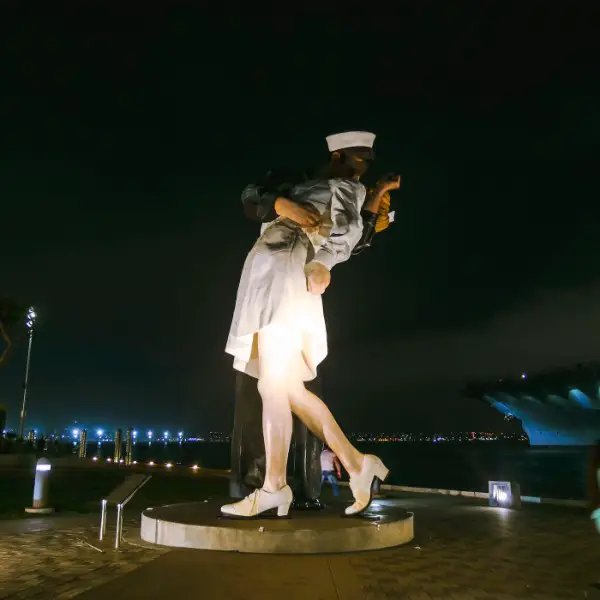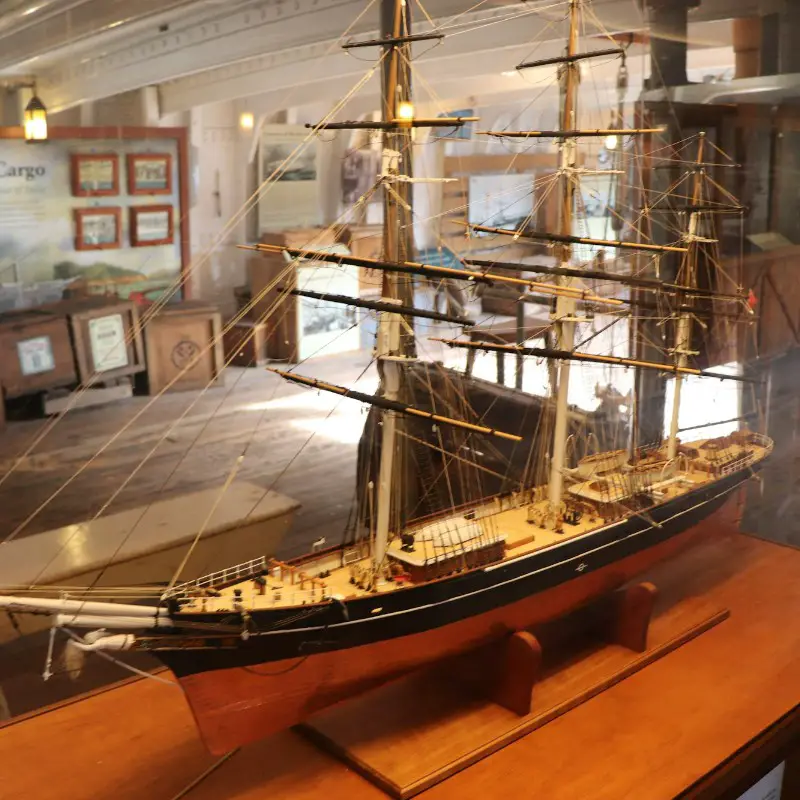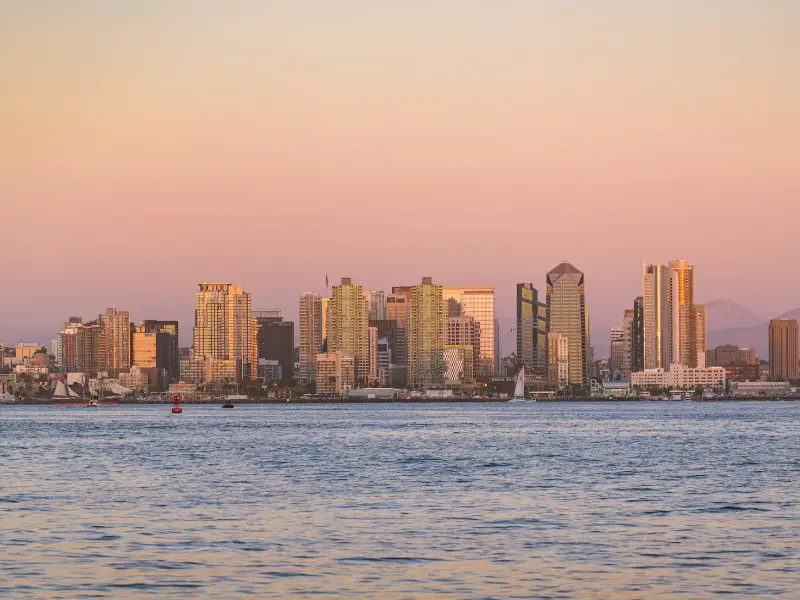San Diego, known for its stunning coastline, vibrant city life, and rich history, is home to numerous iconic landmarks. One such landmark that attracts visitors from all over the world is the famous “Unconditional Surrender” statue, also known as the Kissing Statue in San Diego. This sculpture, located in the downtown waterfront area, holds significant historical and artistic value, making it a must-visit destination for history enthusiasts, art lovers, and curious travelers alike.
Understanding the Unconditional Surrender Statue
The Unconditional Surrender Statue, created by artist Seward Johnson, captures the iconic moment of the unconditional surrender of Japan, marking the end of World War II. The sculpture is based on the famous photograph taken by Alfred Eisenstaedt in Times Square, New York, of a sailor kissing a nurse in celebration of victory.
This statue stands as a symbol of hope, joy, and peace, and has been replicated in several locations around the world, including San Diego.

Standing at the downtown waterfront of San Diego, the statue has become a beloved attraction for locals and tourists alike, serving as a testament to the enduring spirit of the end of World War II.
The Historical Significance of the Kissing Statue in San Diego
The Unconditional Surrender Statue holds immense historical significance. It represents the jubilant celebrations that erupted across the United States and the world at the end of World War II. The famous embrace depicted in the statue symbolizes the relief, joy, and hope felt by millions as the war came to a close.
The sailor and the nurse depicted in the statue were unidentified when the photograph, titled “V-J Day in Times Square,” was first published in Life magazine in August 1945. It was not until later years that the sailor, George Mendonsa, and the nurse, Greta Zimmer Friedman, were recognized. The photograph, taken by Victor Jorgensen, became an enduring symbol of the war’s end and the embrace of peace.
The Unconditional Surrender Statue serves as a public art installation, allowing visitors of all ages to reflect on the historical significance of World War II and the hope it brought to the world. Its larger-than-life size and the embrace captured in the sculpture evoke a sense of joy and unity, reminding us of the sacrifices made by so many during the war.
Quick Facts about the Statue
- The Unconditional Surrender Statue, also known as the Kissing Statue in San Diego, stands on the downtown waterfront.
- Created by artist Seward Johnson, the statue was initially made of temporary materials, but a permanent bronze replacement version was later installed.
- The statue was first unveiled to the public in August 2007 and continues to attract visitors from around the world.
- The sculpture foundation ensured the statue’s presence as a part of the public domain, allowing visitors to enjoy the artwork freely.
- As a testament to the statue’s popularity, replicas have also been displayed in various locations, including Sarasota, Florida, and Key West, Florida.
Controversy Surrounding the Statue’s Replacement
While the Unconditional Surrender Statue has garnered widespread popularity and admiration, it has also faced its fair share of controversy. It was placed in San Diego in 2007 as a “loaner”. One of the key points of contention revolves around the replacement version of the statue in 2013. The public art committee’s decision to replace the temporary display with a permanent bronze replica sparked debates and differing opinions among members of the public.
Public Opinion and Backlash
The replacement version of the Unconditional Surrender Statue fueled public opinion and backlash. Some individuals expressed disappointment or disagreement with the chosen artwork, while others voiced their support for the statue’s preservation. The controversy surrounding the replacement version of the statue gave rise to an ongoing discussion about public art, its significance, and the impact it has on communities.
Public art, like the Unconditional Surrender Statue, has the power to provoke thought, evoke emotions, and promote dialogue. The differing viewpoints highlight the statue’s role as a symbol of history, art, and public sentiment. While the controversy may have divided public opinion, it has also sparked conversations and encouraged the public to reflect on the statue’s meaning and relevance.
The Outcome and Current Status
Despite the controversy, the replacement version of the Unconditional Surrender Statue remains a permanent bronze fixture at the downtown waterfront of San Diego. The statue continues to attract visitors, serving as a historical and artistic focal point of the area. The outcome of the replacement version signifies the enduring legacy of the iconic photograph it represents and the statue’s place in the cultural fabric of the city.
The public art committee’s decision to install the permanent bronze replica reflects their commitment to the statue’s historical significance and the value it holds for the community. The statue stands as a testament to the power of public art to shape public spaces, evoke emotions, and foster conversations.
Exploring the San Diego Harbor Cruise
The San Diego Harbor Cruise offers visitors the opportunity to embark on a scenic journey and explore the city’s waterfront from a unique vantage point. While enjoying the cruise, visitors can catch a glimpse of the Unconditional Surrender Statue from the water, further enhancing their experience and appreciation of this iconic artwork.
Enjoying the View of the Statue from the Water
Viewing the Unconditional Surrender Statue from the water provides a different perspective and allows visitors to fully appreciate its scale, design, and waterfront setting. As the cruise glides along the harbor, passengers can marvel at the statue’s towering presence, capturing breathtaking photographs and creating lasting memories. The juxtaposition of the statue against the city skyline and the sparkling waters of the harbor enhances the overall experience, adding an element of awe and admiration for the artwork and its historical significance.
Other Highlights of the Cruise
- The San Diego Harbor Cruise not only offers a unique perspective of the Unconditional Surrender Statue but also showcases other notable landmarks and attractions along the waterfront.
- Passengers can catch a glimpse of the USS Midway Museum, a renowned aircraft carrier turned museum, which provides an in-depth look into the country’s naval history.
- San Diego Harbor, with its bustling maritime activities, offers a captivating sight of boats, yachts, and ships, creating a vibrant and lively atmosphere.

The downtown waterfront, lined with shops, restaurants, and vibrant art installations, provides a charming backdrop for the cruise, allowing visitors to immerse themselves in the city’s culture and vibrant waterfront scene.
Visiting the Maritime Museum Near the Statue
Adjacent to the Unconditional Surrender Statue, visitors will find the Maritime Museum of San Diego, a treasure trove of maritime history and culture. This museum, housed in the historic ships along the waterfront, offers visitors the opportunity to embark on a journey through time and explore the city’s rich maritime heritage.

Exhibits
- The Maritime Museum of San Diego is home to the USS Midway, an aircraft carrier turned museum, where visitors can step aboard and delve into the fascinating world of naval aviation.
- The museum also features exhibits that delve into the rich maritime history of San Diego, showcasing the city’s role in various eras, including the Pacific Coast during World War II.
- Visitors can explore historic sailing ships, such as the Star of India, the world’s oldest active sailing ship, and the HMS Surprise, a replica of an 18th-century Royal Navy frigate famous for its appearance in the movie “Master and Commander: The Far Side of the World.”
- The museum’s exhibits provide educational and engaging experiences, offering visitors insights into maritime traditions, exploration, and life at sea.
Fun Facts About the Museum
- The Unconditional Surrender Statue, initially displayed in the downtown waterfront of San Diego, was made of foam, paying tribute to the temporary display of the artwork.
- The statue’s temporary display in San Diego served as a testament to the city’s commitment to public art and its appreciation of the iconic photograph it represents.
- The Maritime Museum of San Diego, along with the USS Midway, continues to attract visitors of all ages, offering interactive exhibits, guided tours, and special events.
- The museum provides a unique opportunity to explore historic vessels, experience life at sea, and learn about the role of the maritime industry in shaping the city of San Diego.
Other Nearby Attractions
In addition to the Unconditional Surrender Statue and the Maritime Museum, the downtown waterfront area of San Diego is home to many other attractions that visitors can explore. Tuna Harbor Park, located nearby, offers a serene and picturesque setting for visitors to relax and enjoy the waterfront atmosphere.
The Bob Hope Statue in Tuna Harbor Park
Within Tuna Harbor Park, visitors will find the statue of Bob Hope, a tribute to the legendary entertainer who played a pivotal role in boosting the morale of troops during World War II. The larger-than-life statue stands as a permanent reminder of the entertainment industry’s support for the armed forces during the war. Its presence adds to the artistic and historical significance of the downtown waterfront, attracting visitors with its striking design and contribution to the city’s cultural fabric.
Dining Options Around the Area
Exploring the downtown waterfront area around the Unconditional Surrender Statue and the Maritime Museum offers visitors a wide range of culinary experiences. Whether visitors are looking for a gourmet dining experience or a casual waterfront meal, there are plenty of dining options to suit every palate. Restaurants along the waterfront provide the perfect setting to savor delicious cuisine while enjoying scenic views of the harbor and the city skyline. From fresh seafood to international flavors, the dining scene around the downtown waterfront of San Diego complements the overall visit, allowing visitors to refuel after exploring the city’s rich history, art, and culture.
Frequently Asked Questions
Where is the Kissing Statue located?
The Kissing Sailor statue, also known as the Unconditional Surrender statue, is located in San Diego, California. Specifically, it stands at the downtown waterfront, near the USS Midway Museum. The statue depicts the famous photograph of a sailor kissing a nurse in Times Square during V-J Day, marking the end of World War II. It has become a popular tourist attraction and photo opportunity, drawing visitors from all over the world.
Is the Kissing Statue a free thing to do?
Yes, visiting the Kissing Statue in San Diego is free. The statue, as a part of the public domain, is accessible to all visitors. People can take photos of the statue and learn about its history without any cost. The downtown waterfront area, where the statue is located, also offers various other free activities and attractions, making it an ideal destination for those looking to enjoy San Diego’s vibrant waterfront scenery at no expense.
What are some interesting facts about the Kissing Statue in San Diego that most people don’t know?
The Unconditional Surrender Statue, also known as the Kissing Statue, has several intriguing facts that many people may not be aware of. Here are a few:
- The statue is officially titled “Unconditional Surrender” but gained the nickname “Kissing Statue” due to the famous embrace depicted.
- The sculpture is based on the photograph taken by Alfred Eisenstaedt in Times Square, New York City, on V-J Day, marking the end of World War II.
- The sailor and the nurse in the statue were unidentified when the photograph was first published in Life magazine, and it was not until later years that the individuals in the photograph, George Mendonsa and Greta Zimmer Friedman, were identified.
- The statue originally stood in Sarasota, Florida, before being moved to San Diego, sparking controversy and public discussion.
- Another temporary display of the statue was made of foam, paying tribute to the original artwork.
Conclusion
In conclusion, the Kissing Statue in San Diego is a must-visit attraction that holds historical significance and offers a unique experience. This iconic statue represents the celebration of the end of World War II and symbolizes the joy and relief felt by millions at that time. While there has been controversy surrounding the statue’s replacement, it continues to be a popular spot for tourists and locals alike.

Exploring the San Diego Harbor Cruise provides a stunning view of the statue from the water, and nearby attractions like the Maritime Museum offer additional opportunities for exploration. Whether you’re interested in history, art, or simply enjoying the beauty of the waterfront, the Kissing Statue in San Diego and its surrounding area have something for everyone to enjoy. Book your next vacation!









0 Comments